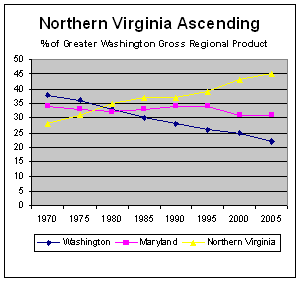|
|
Cup
Half Fuller
George
Mason University's Steven Fuller documents a
powerful trend that stretches back three decades --
Northern Virginia is becoming the center of the
universe.
Every
region in Virginia
or
elsewhere sees itself as the center of the universe.
Why not? After all, this is where I
live, where my
main interests are and where others like me
think the things I
do are important. That's why Richmond, China, Cairo, Fredericksburg,
New York
City and
the White House all are centers of what can only be
explained either as multiple universes or, perhaps,
a multiverse. So one shouldn't be surprised that a
new center is emerging.
Stephen
Fuller, Ph.D., a Professor of Public Policy and
Director of the Center for Regional Analysis at
George
Mason
University
in Fairfax
County, documents
this new, blue star. Several years ago he published
for the first time the statistics on gross regional
product trends in the Greater Washington area. This
primary metropolitan statistical area includes the District of
Columbia, what we
familiarly call Northern
Virginia
and
several counties in Maryland, known as
Suburban Maryland, that surround the District of
Columbia.
PMSAs,
by the way, are designated by gnomes working in the
basement of the U.S. Department of Commerce. They
don't get out much, but do have the power, for
example, to define Hampton Roads as the Norfolk PMSA.
To these people, beyond Washington,
Norfolk, Richmond, Lynchburg, Roanoke
and
Charlottesville, in fact,
there is no Virginia. Only
PMSAs exist. Not surprisingly, these PMSA naming
decisions poison intra-regional relations for many
local governments.
The
interesting thing about the chart that displays
Fuller's statistics on gross regional product trends
are the lines that represent percentage share from
each of the Greater Washington jurisdictions. In
1970 D.C. leads with about 38 percent of the gross
regional product. Suburban Maryland
follows at
about 34 percent and
Northern
Virginia
trails
with about 28 percent. Across the next thirty years,
however, the chart presents an extraordinary
different picture.
The
Fuller chart shows the Suburban Maryland line moving
almost straight across to 31 percentage of gross
regional product in the year 2000, roughly the same
share it had in 1970. D.C.'s share, however, drops
diagonally to 24.6 percent in the year 2000. And
Northern
Virginia
's share
rises steadily, lower left to upper right hand
corner, to total over 43 percent.

Source: Center
for Public Policy, George Mason
University
If
your reaction is Northern
Virginia
is
becoming the center of the universe, you would be
correct. In the decade of the 1990s, for example, 90
percent of the net new jobs created in Greater
Washington were private sector jobs, 85 percent were
in the services sector and 80 percent created were
in Northern
Virginia
. Private
sector service jobs in Northern
Virginia
still is
what's happening in Greater Washington. The
population center of the region also moved across
the Potomac
River
in the
same time period. Together these trends make the
case that we soon may be referring to the Greater
Northern Virginia PMSA – if we can ever get the
Commerce gnomes on the phone.
The
important thing about Fuller's statistics and chart
is that the trend of Northern
Virginia
to become
the economic engine and population center of Greater
Washington occurs regardless of the state of the
economy -- normal, recession or recovery. Further, Fuller projects by 2005 Northern
Virginia
will
produce 45 percent of a gross regional product
estimated at $265 billion. It could be 50 percent by
2010.
Mirroring
these trends are similar ones for
Northern
Virginia's
percentage of the gross state product in
Virginia, again,
regardless of changes in the overall economy. And
therein lies the rub. How will Northern
Virginia
grow into
a broad leadership role anchored in its $105 billion
economy this year growing to $120 billion in 2005?
Will that adjustment be fast, slow, smooth, bumpy,
painful, welcome? How will D.C. and Suburban
Maryland adjust to the movement of the economic and
population center to the Virginia
side of
the Potomac? Let's
hope we're past D.C. trying to march prostitutes
across the 14th
Street
Bridge
into
Arlington
or Maryland
suing Virginia
over water
use from the Potomac
River
.
And
how will Virginia respond to a new regional leader
less concerned with history and "Virginia is
for lovers" than with the technology-driven
future? Like General Assembly redistricting only
every ten years, social and cultural adjustments
required in periods of rapid change take time.
Lagging economic leadership, therefore, are things
such as community leadership, political leadership
and philanthropic leadership. While expectations,
even capabilities can grow in leaps and bounds, new
leaders mature one year at a time. Decades convey
more wisdom than dollars. Humans rarely change
faster than at generational speed.
It
is fascinating to speculate on what Northern
Virginia's ascendancy means. Virginia's governors in
the future not only will meet more regularly with
the governor of Maryland and the mayor of the
District of Columbia, Virginia governors will call
the meetings. More political leaders will travel to
Northern Virginia than business leaders will travel
to Richmond. Fairfax, Prince William and Loudoun
Counties will be the most important localities in
the state. Ambassadors and other international
visitors seeking a good look at American business
prowess will head out the Dulles Toll Road. Other
Virginia regions and institutions will seek direct
economic, educational and other ties with Northern
Virginia executives and institutions, rather than
wait for indirect connections through state
government. Other localities will mimic the can-do
spirit, resource commitments, efficiencies,
innovative solutions, pragmatism and successes that
characterize Northern Virginia schools, water
authorities, economic development agencies and local
governments.
A
myriad of adjustments are ahead for the
Commonwealth. Reassuring for Virginians, however,
should be the understanding that as a result of
these trends, what used to be a part of Greater
Washington will be ever more firmly fixed in the
Commonwealth universe. And blue stars are not only
the newest, they are hottest of all.
--
November 4, 2002

|
|